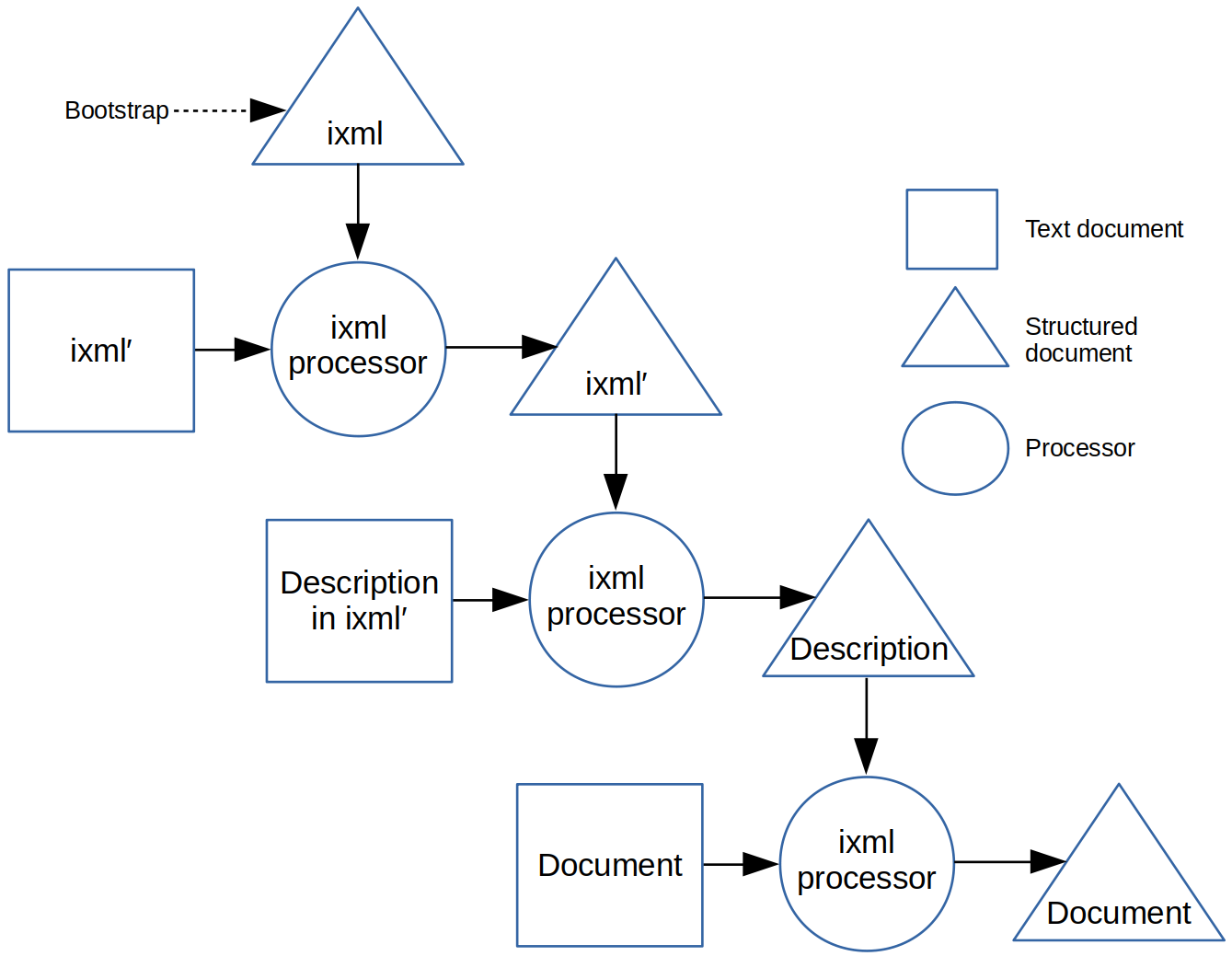ixml: declarative abstract data representation
Steven Pemberton, CWI, Amsterdam

Invisible XML (ixml) is a new notation for expressing data abstractions
Version 1 was officially released in June on invisiblexml.org
Currently 5 implementations known
Long incubation period. 
First vocalised by me on this trip in 2002.
At my first ever keynote, at XML Europe 2004:
"Parsing is quite easy
It would be fairly easy to add a generalised part to the XML pipeline that parsed unmarked-up text, and produced XML as a parse tree: it's just a different sort of transform."
R1: "This is clearly a submission that needs to be shredded, burned, and the ashes buried in multiple locations"
R2: "I think the audience will eat him alive. But I want to be there to hear it."
Went through several iterations.
Working group formed last year.
 Numbers are
abstractions: you can't point to the number three, just three bicycles, or
three sheep, or three self-referential examples.
Numbers are
abstractions: you can't point to the number three, just three bicycles, or
three sheep, or three self-referential examples.
Three is what those bicycles and sheep and examples have in common.
You can represent a number in different ways:
3, III, 0011, ㆔, ३, ፫, ૩, ੩, 〣, ೩, ៣, ໓, Ⅲ, ൩, ၃, ႓, trois, drie.
You can concretise numbers as a length, a weight, a speed, a temperature.
But in the end, they all represent the same three.
We are often obliged for different reasons to represent data in some way or another.
But in the end those representations are all of the same abstraction; there is no essential difference between the JSON
{"temperature": {"scale": "C"; "value": 21}}
and an equivalent XML
<temperature scale="C" value="21"/>
or
<temperature> <scale>C</scale> <value>21</value> </temperature>
or indeed
temperature: 21°C
since the underlying abstractions being represented are the same.
Takes a representation of data (typically with implicit structure).
Uses a description of the format of that data to recognise the data's structure.
Creates an internal representation of the data, now with the structure made explicit.
Which can be used for multiple purposes, including creating an external representation with explicit structure.
Some representations are weaker than others: they may not be able to faithfully represent all of the abstraction, and are therefore not reversible.
XML is probably the best available general notation for generating the representation of any abstraction.
The intention behind ixml is to allow extracting abstractions from representations; of converting weaker representations of abstractions into stronger ones, with XML therefore an excellent target for that.
19 October 2022
Describe the format:
date: day, " ", month, " ", year. day: digit, digit?. month: "January"; "February"; ...; "December". year: digit, digit, digit, digit. digit: ["0"-"9"].
Process the input with this description, and get:
<date>
<day>
<digit>1</digit>
<digit>9</digit>
</day>
<month>October</month>
<year>
<digit>2</digit>
<digit>0</digit>
<digit>2</digit>
<digit>2</digit>
</year>
</date>
19 October 2022
Describe the format:
date: day, " ", month, " ", year. day: digit, digit. month: "January"; "February"; ...; "December". year: digit, digit, digit, digit. -digit: ["0"-"9"].
Process the input with this description, and get:
<date> <day>19</day> <month>October</month> <year>2022</year> </date>
Add another format option:
19/10/2022
Add to the description:
date: day, " ", month, " ", year;
day, "/", nmonth, "/", year.
day: digit, digit?.
month: "January"; "February"; ...; "December".
nmonth: digit, digit?.
year: digit, digit, digit, digit.
-digit: ["0"-"9"].
Process the input with this description, and get:
<date> <day>19</day>/ <nmonth>10</nmonth>/ <year>2022</year> </date>
dates: date+.
Better:
dates: (date, " "*)+.
or:
dates: date++", ".
for
19/10/2022, 31 December 2022, 1/1/2023
date: day, " ", month, " ", year;
day, "/", nmonth, "/", year.
@day: digit, digit?.
@month: "January"; "February"; ...; "December".
@nmonth: digit, digit?.
@year: digit, digit, digit, digit.
-digit: ["0"-"9"].
with input
19/10/2022
gives
<date day="19" nmonth="10" year="2022">//</date>
date: day, -" ", month, -" ", year;
day, -"/", nmonth, -"/", year.
@day: digit, digit?.
@month: "January"; "February"; ...; "December".
@nmonth: digit, digit?.
@year: digit, digit, digit, digit.
-digit: ["0"-"9"].
with input
19/10/2022
gives
<date day="19" nmonth="10" year="2022"/>
ixml reports ambiguous input.
A grammar accepting both World and USA style dates, with month only 1-12, and day 1-31:
date: us; world.
us: month, -"/", day, -"/", year.
world: day, -"/", month, -"/", year.
month: "0"?, ["1"-"9"];
"10"; "11"; "12".
etc
the input 04/10/2021 would produce:
<!-- AMBIGUOUS
The input from line.pos 1.1 to 1.11 can be interpreted as 'date' in 2 different ways:
1: us[:1.11]
2: world[:1.11]
-->
<date ixml:state="ambiguous" xmlns:ixml="http://invisiblexml.org/NS">
<us>
<month>04</month>
<day>10</day>
<year>2021</year>
</us>
</date>
The hardest part of getting an article into Docbook format (the format used by several conferences I go to) is getting the bibliography right.
The bibliography for a recent paper was produced with the help of ixml. For instance, the text
[spec] Steven Pemberton (ed.), Invisible XML Specification, invisiblexml.org,
2022, https://invisiblexml.org/ixml-specification.html
was processed by an ixml grammar whose top-level rules were
bibliography: biblioentry+.
biblioentry:
abbrev, (author; editor), -", ",
title, -", ",
publisher, -", ", pubdate, -",",
(artpagenums, -", ")?,
(bibliomisc; biblioid)**-", ", -#a.
<biblioentry>
<abbrev>spec</abbrev>
<editor>
<personname>
<firstname>Steven</firstname>
<surname>Pemberton</surname>
</personname>
</editor>
<title>Invisible XML Specification</title>
<publisher>invisiblexml.org</publisher>
<pubdate>2022</pubdate>
<bibliomisc>
<link xl-href='https://invisiblexml.org/ixml-specification.html'/>
</bibliomisc>
</biblioentry>
 An ixml processor takes a document in a particular
(textual) format, along with a description of that format, in the form of a
grammar, and uses it to parse the document.
An ixml processor takes a document in a particular
(textual) format, along with a description of that format, in the form of a
grammar, and uses it to parse the document.
This produces a structured parse tree, which can then be processed in a number of ways, such as serialization as XML.
 The
format description is drawn as a structured document.
The
format description is drawn as a structured document.
However, it is normally supplied in textual form, and is processed in exactly the same way, by the ixml processor, but using a description of the ixml format.
This results in the structured version of the description.

ixml is of course expressed in ixml:
rule: (mark, s)?, name, s, -["=:"], s, -alts, -".".
which comes out as XML
<rule name='rule'>
<alt>
<option>
<alts>
<alt>
<nonterminal name='mark'/>
<nonterminal name='s'/>
</alt>
</alts>
</option>
<nonterminal name='name'/>
<nonterminal name='s'/>
<inclusion tmark='-'>
<member string='=:'/>
</inclusion>
<nonterminal name='s'/>
<nonterminal mark='-' name='alts'/>
<literal tmark='-' string='.'/>
</alt>
</rule>

What many miss on first introduction to ixml is the essential role of the abstract document: everything else is just representation.
The ixml description language plays three roles:
What this means, for instance, that even the ixml description language is mutable: as long as the structure of the abstract description stays the same, you can use any syntax you like.
Instead of
rule: (mark, s)?, name, s, -["=:"], s, -alts, -".". name: namestart, namefollower*.
you could define an equivalent language using:
rule: (mark, s)?, name, s, -"::=", s, -alts. name: -"<", namestart, namefollower*, -">".
and then define languages using BNF instead:
<rule> ::= (<mark>, <s>)? <name> <s> -"::=" <s> -<alts> <name> ::= -"<" namestart namefollower* -">"

You have now seen the essence.
For full details read the specification, or see the tutorial.